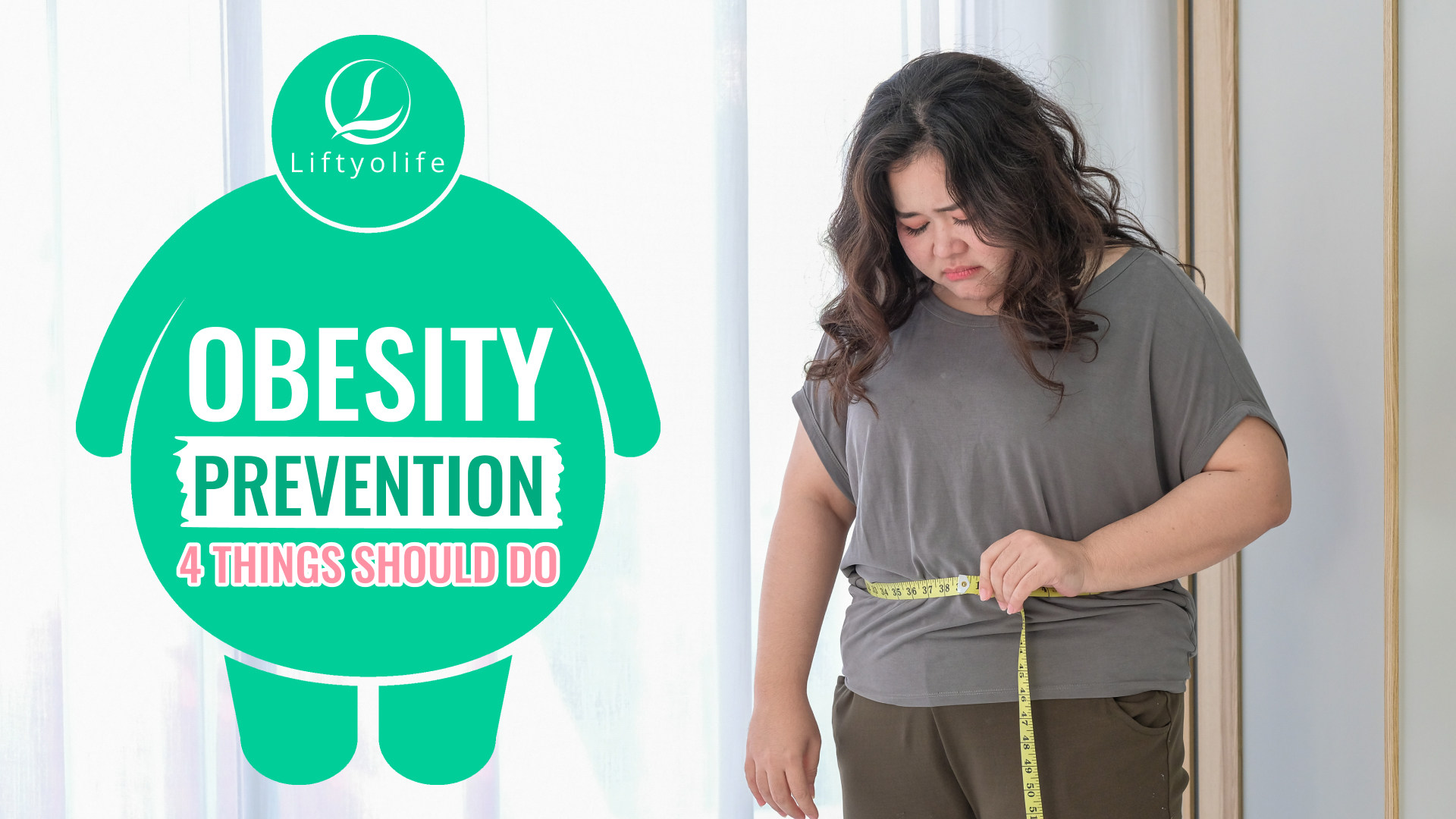How To Prevent Obesity?

How to prevent obesity? Obesity-related conditions are type 2 diabetes, heart disease, stroke, and some cancers. These are among the leading causes of avoidable death. Furthermore, estimates of the annual medical cost of adult obesity in the U.S. range from $147 billion to nearly $210 billion. Most of the money is spent on obesity-related diseases like diabetes and cardiovascular disease, among others. As a result, go with us to prevent obesity today to reduce the risk of dangerous conditions and save money on treatment. Liftyolife (liftyolife.com) will be your traveling companion.
1. Facts about prevention obesity
Obesity is a chronic disease afflicting an increasing number of children, adolescents, and adults. Obesity was prevalent in 19.3% of children and adolescents aged 2 to 19 in 2017-2018, affecting around 14.4 million children and adolescents. The age-adjusted prevalence of obesity in adults was 42.4% during the same period, with no significant distinction between men and women overall or by age group. Specific populations are also more prone to childhood obesity.
Given the chronic diseases associated with obesity and the difficulty in treating obesity, prevention is critical. Healthcare professionals are seeing an increase in the onset of type 2 diabetes, heart and blood vessel disease, obesity-related depression, and social isolation in children and adolescents. Obesity-related risk factors become more significant the longer a person is obese.
One of the primary reasons childhood obesity prevention is so important in children is that it persists into adulthood and increases as the child grows older. This increases the individual’s diabetes, high blood pressure, and heart disease.
2. How to prevent obesity
2.1. Prevent obesity by sleeping

Prevent obesity by sleeping
A good night’s sleep is good for health, and it may also be essential for maintaining a healthy weight. People getting too little sleep are more likely to gain weight and become obese than those who sleep 8 hours per night.
Sleep deprivation may increase energy intake:
- Increased hunger: Sleep deprivation can cause changes in the hormones that control appetite.
- Allowing people more time to eat: People who sleep less at night may eat more than those who get a full night’s sleep because they have more waking time.
- Causing people to eat less healthy diets: A study of Japanese workers found that workers who slept under 6 hours per night were more likely to eat out, have more irregular meals, and snack than those who slept over 6 hours.
Sleep deprivation may reduce energy expenditure by:
- Reduced physical activity: People who don’t get enough sleep are tired during the day and may limit their physical activity.
- Lowering body temperature: People sleep-deprived tend to have lower body temperatures in laboratory experiments. Thereby, energy expenditure may be reduced.
2.2. Prevent obesity by relaxing

Prevent obesity by relaxing
Chronic stress raises the stress hormone cortisol, which leads to weight gain. Cortisol and other stress hormones can boost “carbohydrate cravings” and make it challenging to exercise sound judgment and willpower.
In some obese patients, stress is a critical factor in inducing overeating as a form of maladaptive coping. At a 3-month follow-up after discharge, relaxation training effectively reduced emotional eating episodes, depressive and anxiety symptoms and improved perceived self-efficacy for eating control. We conclude that relaxation training aided by new technologies could be an effective tool for reducing emotional eating episodes and, as a result, weight, and obesity.
Consider the various healthy ways to deal with stress and find the one that works best for you. Take a walk daily, practice yoga or meditate, listen to your favorite music, meet friends, or do something that makes you happy.
2.3. Exercise
How can exercise help you avoid obesity?
- Reduces waist fat and total body fat, slowing the progression of abdominal obesity.
- Raises people’s total energy expenditure, which can help them maintain energy balance or even lose weight if they don’t eat more to compensate for the extra calories they burn.
- Reduces depression and anxiety and this mood boost may encourage people to stick to their exercise routines over time.
- Weight lifting, push-ups, and other muscle-strengthening activities increase muscle mass, increasing the energy the body burns throughout the day – even when at rest – and making weight control easier.
What should you do?
- The average adult ought to get a minimum of 150 minutes per week of moderate-intensity physical activity. This equates to a minimum 30 minutes per day, five days per week.
- According to the Health Survey for England, brisk walking is the best exercise for maintaining a healthy weight (Grace Lordan, 2015).
- Researchers discovered that people who walk at a brisk or fast pace are more likely to be lighter, have a lower body mass index (BMI), and have a smaller waist circumference than people who do other activities (Grace Lordan, 2015).
- Furthermore, experts recommend staying active throughout the day, whether through a standing desk, frequent stretch breaks, or finding ways to work in walking meetings throughout the day.
2.4. Diet

Prevent obesity by going on diet
- Avoid highly processed foods: These foods, such as white bread and many boxed snack foods, are familiar sources of empty calories, which can quickly add up.
- Eat five a day: Aim for five to seven servings of whole fruits and vegetables per day. Low-calorie foods include fruits and vegetables. According to the World Health Organization, there is compelling evidence that eating fruits and vegetables reduces the risk of obesity.
- Reduce your sugar intake: It is critical to limit your intake of added sugars. The American Heart Association recommends that women consume no more than six teaspoons of added sugar one day and men consume no more than nine teaspoons one day.
- Avoid saturated fats: According to a 2018 study, eating foods high in saturated fat contributes to obesity. Instead, prioritize sources of healthy fats such as avocados, olive oil, and tree nuts. Even healthy fats should be limited to 20 to 35% of daily calories.
- Limit artificial sweeteners: They have been linked to obesity and diabetes. If you must use a sweetener, try a small amount of honey, which is a natural option.
- Try a plant-based diet: Eating a veggies-based diet has improved overall health and lower obesity rates.
- Cook at home: According to studies on the frequency of home meal preparation, those who prepared meals at home were less likely to gain weight.
3. Obesity prevention for adults

Obesity prevention for adultsStart setting and sticking to a healthy living plan to control your weight actively. These are some steps you can take to lose or maintain your desired weight. Let’s get started right away with these suggestions:
3.1. Eat plenty of dietary fiber
The fiber in the diet will tend to prevent excessive food intake and depot fat accumulation by:
- decreasing the caloric density of the diet,
- stowing rate of food ingestion,
- increasing the effort involved in eating,
- promoting intestinal satiety,
- interfering slightly with energy absorption efficiency.
In one 2012 study, people who took a fiber complex supplement three times daily for 12 weeks lost up to 5% of their body weight.
3.2. Eat more servings of vegetables and fruits
Fruits and vegetables are always the best choices when it comes to your health and weight. Adults are recommended to consume five to nine servings of fruits and vegetables per day. Filling your plate with these types of food can help you keep your calories in check and reduce your risk of overeating.
3.3. Consume less processed and sugary foods
A study in The American Journal of Clinical Nutrition said consumption of processed and ultra-processed foods is associated with an increased risk of obesity. Many processed foods contain a lot of fat, salt, and sugar, leading to overeating.
3.4. Consume less “bad” fat and more “good” fat
A study in the Nutrition Journal said that eating healthy dietary fats like polyunsaturated fats can improve cholesterol levels and lower the risk of obesity.
Polyunsaturated fats are abundant in the diet.
- Oils from sunflower, corn, soybeans, and flaxseed
- Flax seeds, walnuts
- Canola oil – Although higher in monounsaturated fat, it is also high in polyunsaturated fat.
Omega-3 fatty acids are a typical type of polyunsaturated fat. Because the body cannot produce these, they must be obtained from food.
- Eating fish 2-3 times per week is an excellent way to get omega-3 fats.
- Flax seeds, walnuts, canola, or soybean oil are all good plant sources of omega-3 fats.
3.5. Focus on eating low–glycemic index foods
The glycemic index (GI) is a scale that determines how quickly a food item raises blood sugar. Focusing on low-GI foods can help stabilize blood sugar levels. Maintaining stable blood glucose levels can aid in weight management.
Whole Grain foods, fruit, vegetables, beans, and lentils are examples of low GI foods we should consume as part of a healthy, balanced diet.
3.6. Learn how to food budget and meal prep
It is much easier to go grocery shopping for healthy foods when you have a plan. Creating a food budget and shopping list for your shopping trips can help you avoid unhealthy food temptations. Furthermore, meal preparation can provide you with ready-to-eat healthy meals.
3.7. Engage in regular aerobic activity
Regular physical activity is a key to weight maintenance or loss, among other benefits. The Centers for Disease Control and Prevention recommends 150 minutes of moderate aerobic activity or 75 minutes of vigorous aerobic activity per week.
3.8. Get the family involved in your journey
Social support isn’t just for kids and teenagers; it’s also essential for adults to feel supported. Whether it’s cooking with family or going on walks with friends, involving others can help to promote a healthy lifestyle. The power of a collective effort is one thing that can inspire you and keep your motivation alive.
3.9. Focus on reducing daily stress
Stress can have various effects on both the body and the mind. Why? When you are stressed or anxious, your body produces a lot of cortisol. This can lead to an increase in appetite and a preference for “comfort food,” as well as a redistribution of white adipose tissue to the abdominal region, leading to abdominal obesity.
3.10. Incorporate a weight training regimen
Weight training is just as crucial for weight management as aerobic exercise. In addition to weekly aerobic activity, the WHO recommends weight training with all of your major muscles at least twice a week.
4. Obesity prevention for kids

Obesity prevention for kids
4.1. Eat healthy foods as a family
Changing eating habits in the family allows children to learn about healthy eating from an early age. This makes it easier for them to maintain healthy eating habits as they grow older.
4.2. Feed growing children appropriate portion sizes
Parents can manage what their children eat and do not eat, allowing them to control their children’s weight from when they begin weaning. According to the American Academy of Pediatrics, toddlers do not require a lot of food. From 1 to 3 years old, every inch of height should correspond to approximately 40 calories of food intake.
4.3. Encourage eating slowly and only when hungry
Hungry is your body’s signal that it is running low on energy and requires more. Overeating can occur if you eat when you are not hungry. This extra fuel is eventually stored as body fat, leading to obesity. Encourage your child to eat only when hungry and chew slowly to better digestion.
4.4. Breastfeed infants, when possible
Breastfeeding was linked to a lower risk of childhood obesity in a 2014 meta-analysis of 25 studies. However, studies on the role of breastfeeding in obesity prevention are mixed, and more research is needed.
4.5. Limit unhealthy foods in the household
Your kids attend to eat more food if it is available or right in front of their eyes. So, if you bring unhealthy food into the home, your children are more likely to consume them. Let’s stock the fridge and pantry with healthy foods and serve them as healthy snacks.
4.6. Build early relationships with healthy foods
Encourage your children to try new fruits, veggies, and proteins early. They may be more likely to incorporate these healthy foods into their diet as they get older.
4.7. Limit your child’s screen time
More time spent in front of a screen means less time for physical activity and adequate sleep. Because exercise and sleep are essential factors in maintaining a healthy weight, it is important to prioritize those activities over computer or TV time.
4.8. Make sure everyone is getting enough sleep
Sleeping allows your body and mind to relax and recover. According to research, both children and adults who do not get enough sleep may weigh more. In addition, according to the National Sleep Foundation, healthy sleep habits include a sleep schedule and a comfortable pillow and mattress.
4.9. Know what your child is eating outside of the home
Outside of the home, children have numerous opportunities to consume unhealthy foods, whether at school, with friends, or while being babysat. You can’t always watch what they eat, but you can help by asking questions.
4.10. Incorporate fun and exciting physical activity
WHO recommends children and adolescents participate in at least 60 minutes of physical activity per day. Games, sports, gym classes, and even outdoor chores are examples of enjoyable physical activities.
5. Why does prevention matter?
Obesity prevention is essential for good health because obesity is linked to chronic health conditions, many of which become more severe to treat over time.
In addition, one of the primary reasons childhood obesity prevention is so important in children is that childhood obesity persisting into adulthood increases as the child grows older. This increases the individual’s diabetes, high blood pressure, and heart disease.
Among these conditions caused by obesity are:
- Diabetes type 2.
- Metabolic syndrome.
- Stroke.
- Excessive blood pressure.
- Gallbladder disease.
- Cardiovascular disease.
- Excess triglycerides and low “good” cholesterol.
- Obstructive sleep apnea.
- Nonalcoholic fatty liver disease (NAFLD).
- Problems with sexual health.
- Mental health issues.
- Osteoarthritis.
6. Have we made progress?
Over time, many studies on obesity have been conducted to determine the truth and consequences of this disease. As a result, many interventions to reduce obesity rates are highly effective. Here’s an example of typical evidence of the development:
A 2012 Australian study looked at the role of home-based nurses in the weight management of children up to the age of two. After birth, the nurses visited the babies eight times and encouraged the mothers to incorporate healthy practices. According to the researchers, the average BMI of the children in this group was significantly lower than that of the control group (babies who did not receive the eight nurse visits).
A 2018 trial in Sweden, on the other hand, looked at the effectiveness of a smartphone app for teaching young children about healthy eating and physical activity. After a year, the researchers discovered no significant differences in BMI or other health markers between the two groups.
Obesity-related risk factors become more significant the longer a person is obese. Given the chronic diseases and conditions associated with obesity and the difficulty in treating obesity, prevention is critical. So, how to prevent obesity? Have you found the best solution for you? Let’s start small and work our way up. Better things will come gradually. Let Liftyolife (liftyolife.com) be your one hand.
==> Read More:







